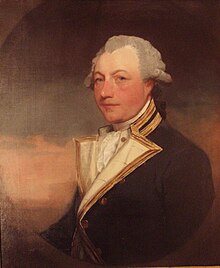Sir Robert Kingsmill, 1st Baronet
| Sir Robert Kingsmill, Bt | |
|---|---|

Admiral Sir Robert Kingsmill by Gilbert Stuart
|
|
| Born | 1730 Belfast, Ireland |
| Died | 23 November 1805 Sydmonton Court, Kingsclere, Hampshire |
| Allegiance |
|
| Service/branch |
|
| Years of service | 1746–1805 |
| Rank | Admiral of the Blue |
| Commands held |
HMS Swallow HMS Basilisk HMS Crescent HMS Vigilant HMS Elizabeth HMS Duke Cork Station |
| Battles/wars |
Seven Years' War American War of Independence French Revolutionary Wars Napoleonic Wars |
Sir Robert Brice Kingsmill, 1st Baronet (1730 – 23 November 1805) was an officer of the Royal Navy who served during the Seven Years' War, the American War of Independence and the French Revolutionary and Napoleonic Wars in a career that spanned nearly 60 years. Kingsmill was a contemporary and close friend of Lord Nelson, and was one of the prominent Royal Navy admirals of his time referred to as "The Conquerors of the Seas," illustrated in Piercy Roberts' 1800 engraving. He served with Rodney in the West Indies, where he was wounded in battle, and with Keppel at the Battle of Ushant. He took the time to embark on a career in politics as a Member of Parliament, giving this up several times to resume his service in the Navy when war broke out. Kingsmill rose to flag rank by the time of the outbreak of war with revolutionary France in 1793. As the naval commander-in-chief on the coast of Ireland, he repelled several attempts by the French to invade Ireland and foment insurrection. Kingsmill died on 23 November 1805 at Sydmonton Court as a baronet and with the rank of Admiral of the Blue.
He was born in Belfast as Robert Brice, the son of Captain Charles Brice, of Castle Chichester, and his wife Jane. He followed his father into the navy, joining the 14-gun sloop HMS Speedwell as an able seaman on 29 October 1746. He remained with the Speedwell for several years, being promoted to midshipman on 3 October 1748, and having passed his lieutenant's examination on 5 July 1754, received his commission on 29 April 1756. The outbreak of the Seven Years' War offered further opportunities for advancement, and in February 1761 he was promoted to master and commander of the sloop HMS Swallow. His capture of the 10-gun French privateer Sultan led to the confirmation of his rank on 3 July, and he soon received an appointment to the bomb vessel HMS Basilisk. It was during this period that he was recalled and placed in command of one of the yachts preparing to carry Princess Charlotte of Mecklenburg-Strelitz and her suite to England to marry King George III. The voyage was hampered by fierce storms, but all of the yachts and their naval escorts arrived safely. He then returned to the Basilisk and sailed to the West Indies with Rear-Admiral George Rodney's fleet. Brice assisted with the assaults on Martinique and St Lucia, during which he was wounded.
...
Wikipedia
